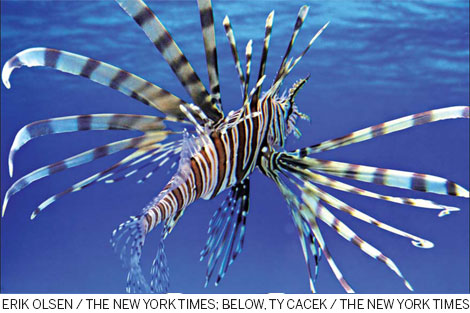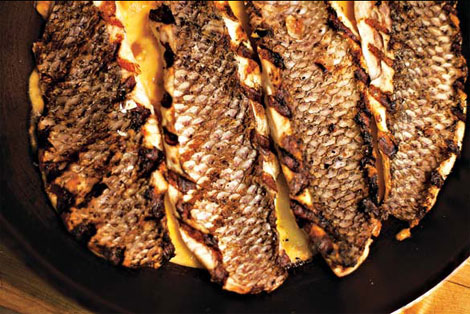Delicacies
To curb invasives, eat them
Updated: 2011-07-31 08:28
By Elisabeth Rosenthal (The New York Times)

|
Consuming invasive creatures could take pressure off of overfished natural species. A lionfish in the wild, top, and wild tilapia, plated. |
With its dark red and black stripes, spotted fins and long venomous black spikes, the lionfish seems better suited for horror films than consumption. But lionfish fritters and filets may be on American tables soon.
An invasive species, the lionfish is devastating reef fish populations along the Florida coast and into the Caribbean. Now, an increasing number of environmentalists, consumer groups and scientists are seriously testing a novel solution to control it and other aquatic invasive species - one that would also take pressure off depleted ocean fish stocks: they want people to start eating invasive critters in large numbers.
"Humans are the most ubiquitous predators on earth," said Philip Kramer, director of the Caribbean program for the Nature Conservancy. "Instead of eating something like shark fin soup, why not eat a species that is causing harm, and with your meal make a positive contribution?"
Invasive species have become a vexing problem in the United States, with population explosions of Asian carp clogging the Mississippi River and European green crabs mobbing the coasts, eating native creatures and out-competing them for food.
While most invasive species are not commonly regarded as edible food, that is mostly a matter of marketing, experts say. Imagine menus where Asian carp substitutes for the threatened Chilean sea bass, or lionfish replaces grouper, which is overfished.
"We think there could be a real market," said Wenonah Hauter, the executive director of Food and Water Watch, whose 2011 Smart Seafood Guide recommends for the first time that diners seek out invasive species as a "safer, more sustainable" alternative to their more dwindling relatives.
Scientists emphasize that human consumption is only part of what is needed to control invasive species, and that a comprehensive plan must include restoring fish predators to depleted habitats and erecting physical barriers.
"We are not going to be able to just eat our way out of the invasive species problem," Dr. Kramer said.
There are risks to whetting America's appetite. Marketing an invasive species could make it so popular that "individuals would raise or release the fish," said Valerie Fellows, a spokeswoman for the United States Fish and Wildlife Service. Tilapia, a fresh water fish, was originally imported into Latin America for weed and bug control, but commercialization helped the species spread far more widely than intended.
Dr. Kramer is concerned that the marketing of lionfish might increase the number of traps on reefs. He said spearfishing was the sustainable way to catch them.
To increase demand for items few people consider edible, Food and Water Watch has teamed up with the James Beard Foundation and the South Gate restaurant in New York City to devise recipes using the creatures. At a recent tasting, there was Asian carp ceviche and braised lionfish filet. Lionfish, it turns out, looks hideous but tastes great.
Last summer, the Nature Conservancy sponsored a lionfish food fair in the Bahamas, featuring lionfish fritters and more. They offered fishermen about the same price per kilogram as they would get for grouper, and got an abundant supply.
Lionfish, native to the Indian Ocean and South Pacific, arrived in the Caribbean in the early 1990s and are spreading rapidly; voracious eaters, they even eat juveniles of native fish. Like grouper, they can carry ciguatoxin, which causes vomiting and neurological symptoms, so they cannot be taken from water where the microbe that produces the toxin is found.
"What these species need now," Ms. Hauter said, "is a better - sexier - profile."
The New York Times
E-paper

Double vision
Prosperous Hangzhou banks on creative energies to bridge traditional and modern sectors
Minding matters
A touch of glass
No longer going by the book
Specials

Carrier set for maiden voyage
China is refitting an obsolete aircraft carrier bought from Ukraine for research and training purposes.

Pulling heart strings
The 5,000-year-old guqin holds a special place for both european and Chinese music lovers

Fit to a tea
Sixth-generation member of tea family brews up new ideas to modernize a time-honored business

